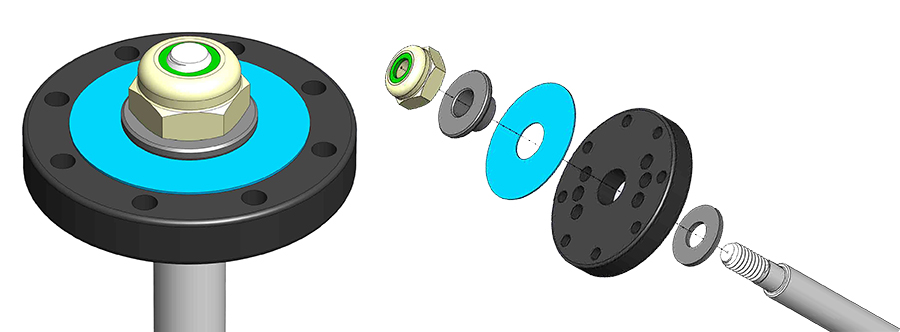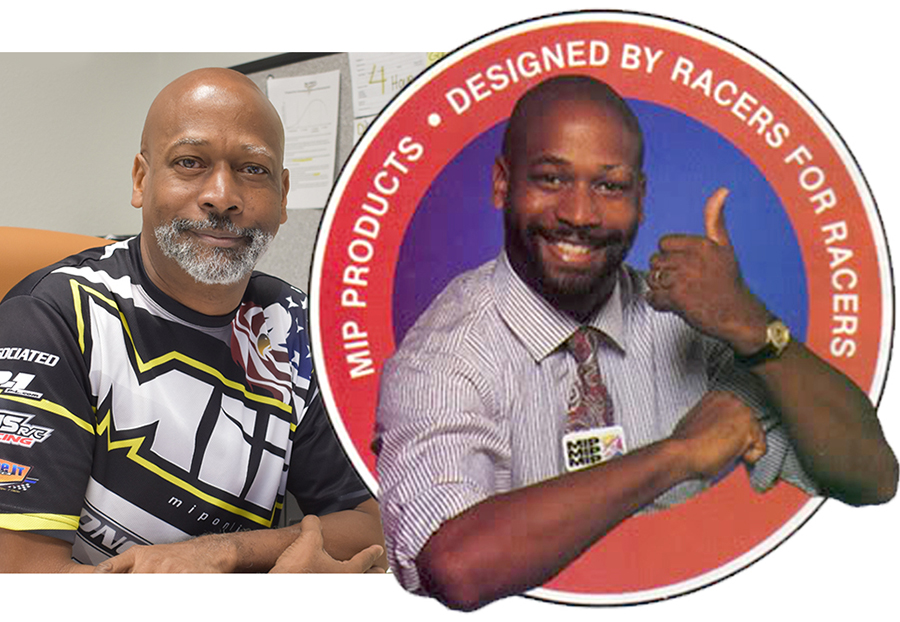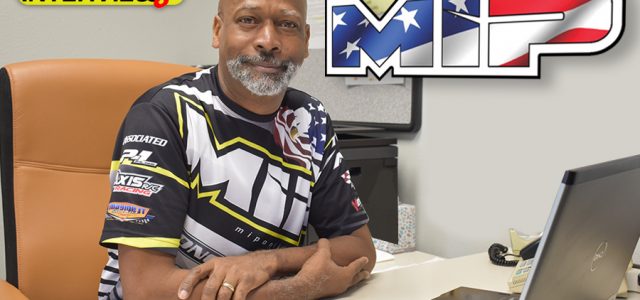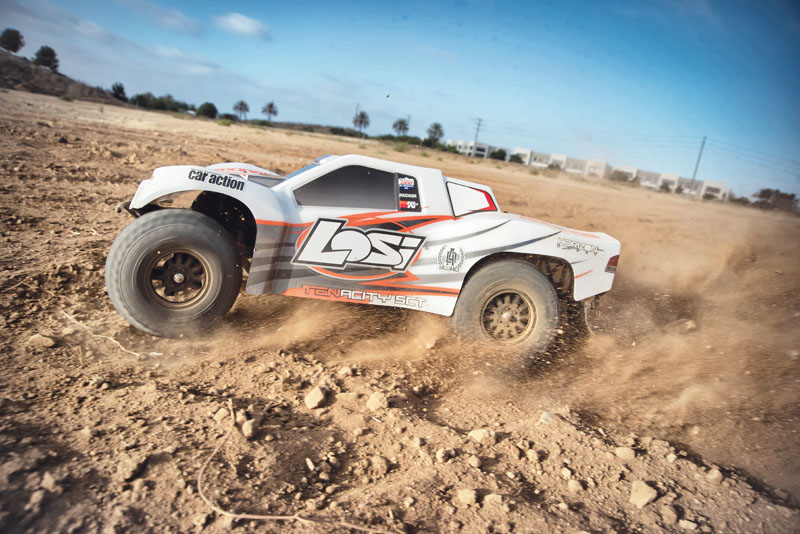Moore’s Ideal Products, LLC, better known as “MIP,” is without a doubt one of RC’s most legendary brands. MIP products have been driving our vehicles—literally—for ages. MIP is now celebrating its 41st year in business, so we took some time to sit down with Eustace Moore, amazing product creator, master machinist, and RC innovator to talk about MIP’s history and his experiences in a lifetime in this hobby. He’s not only a masterful engineer with a creative mind but also a racer, an inventor, and one of our hobby’s true masters.

Looks like MIP is a fun place to be! Always nice to work someplace cool.
RC Car Action: MIP’s amazing 41 years in RC is something rarely heard of, especially in today’s market, so let’s start from the beginning. How did MIP come to be?
Eustace Moore: I became an RC enthusiast when I was about 10 years old, back in the early ’70s, and immediately fell in love with the cars. My first RC vehicles were actually airplanes. I would build and design my own and fly them, and then I discovered the cars. Later in life, the business started when I was creating things for myself; my friends saw them and asked, “Hey, can you make one for me?” It just sort of grew from there. Before I knew it, one person wanted something, then two, then 20, and then folks in other states and other countries. What’s funny is we still do the same thing today. We’ll make a product that we want ourselves as enthusiasts and as racers. And while it’s a little more in depth now, with a customer base and all, if it’s something that we like or you like, then we produce it. Hopefully, it’s something that people can afford.

Racing has always been a been a big part of what MIP does, and it’s driven a lot of your product development. What was it like for you to compete at those events in the early years?
I was always extremely competitive, so when I was there, I was there to win. The atmosphere was great, and we had some amazing times. It was much different than it is today because, back then, we built a lot of our own machines and people were doing a lot more creating and testing at those events. Now people tend to run things that are more standardized with some upgrades; people were inventing their own upgrades back then. It was a different level of imagination that people had then. I think things are still just as exciting; of course, our equipment wasn’t as amazing as it is now.
Do you think maybe we’ve lost a little bit of that imagination now?
I don’t think that we’ve lost it—I think it just isn’t as necessary. Machine shop, mechanic shop, and drafting aren’t taught in schools like they used to. If you happen to learn a skill on how to build, weld, or solder, it’s from online sources, but people just aren’t into it like they used to be. I feel like that’s where all the ready-to-run stuff came into play, too. It brought more people in but not people who were as interested in the mechanical end of it.
In all your years racing and in RC, are there any stand-out memories or funny stories you can share of your travels?
(Laughing) Not specifically I guess, but over the years, I’ve stayed at dozens and dozens of people’s homes and with their families, especially in the early years. Back then, if you were invited to an event, you were staying at someone’s house; there wasn’t really a lot of staying in hotels or even renting cars. You’d get picked up at the airport, hang out and race for a few days, and head home afterward. It does still exist a little bit; Matt [Olson] does a lot of the travel for the company now, and he spends a lot of time with racers and their families in their homes, and for me, that’s really special. I remember this one family I stayed with; this guy must’ve had 10 kids and he was a trucker, so when he’d come through here, he’d visit—and he lived in Montana, I think. So he invited me to an event, and I stayed with his family. It was like The Brady Bunch—there were so many kids. But we had a great time. We’d do dinner with the family, and they’d say their prayers and tuck everyone into bed—and I got tucked in too, of course. They were great, positive memories but mainly because of the social part of it and spending time with people. The other exciting thing is watching kids grow up. I’m now in my third generation of RC racers—people I raced with who had kids and then they had kids who race. It’s been very rewarding because of that.
A lot of people may not realize this about you, but back in those early days, you were creating products and racing on the pro level internationally. What was it like for you racing at something like an IFMAR World Championship? What did you take away from those experiences for yourself and for your products?
Those days, I think it was more difficult for me in racing because I was trying to create so many new products and compete at the same time. It was hard working long hours, having to create, then manufacture and source, and keep the company running. At the same time, though, it was probably our most creative stint in the company because, at that time, we were almost producing an entire car’s worth of parts. It definitely was tough, but we survived and have grown quite a bit as a result of that.
You’ve raced long enough to see just about every generation of pro come through. All eras considered, who do you think are some of the most impressive racers you’ve seen?
I would say Masami [Hirosaka] would definitely be number one, of course. I mean, he can drive with his feet! For number two, I would say Ryan Maifield, without a doubt. When I watch him drive, he’s literally in the car and using every inch of that racetrack, making the car perform and feeling it.
Do you think that’s what separates most people from the top tier of drivers?
Where you truly see the talent of any driver is how deep they’ll go into a corner. When I was younger, I’d brake in the corner and I would be looking far enough ahead to find the exit to get to the next point. Now, I’m more just flowing. I’m not braking earlier, and I’m not as tight in the corners. It’s not because I’m not confident in the corners as much as I can’t see as well or my timing and ability to move as quickly is off a little bit. You see that in all racers as they start aging: They’re still fast, but they’re not hitting that point as quickly as they used to. The guys at the top level though, the ones who are on the world level, they’re on point all the time.
Who do you think is the next Masami or Ryan?
I honestly don’t think we’re ever going to see another Masami. The things he did were just magical. There are lots of racers out there who are very talented and very fast but not at the level he was back in his era.

The 4-10 Legend converted the Team Associated RC10 to 4WD. If you saw this ad, you wanted one.
For vintage collectors, the biggest MIP product, without a doubt, is the 4-10 Legend 4WD kit for the Associated RC10. How did that kit come to be, and have you considered rereleasing it?
I had a vision for how 4WD would enhance the performance of a RC car, and there were a few cars at the time that were already 4WD, but they didn’t have the suspension, overall handling, and powertrain characteristics that the RC10 did. So it was really just a matter of trying to marry the two together, and I think we made it work. As far as a consideration for a rerelease, of course there is a possibility. If we did a new version, a modern version, it might look very similar visually but structurally it would be quite different because we have better materials now and our manufacturing capability is 10 times better than it was back then. We’ve been considering it for probably the past five years or so. It isn’t going to happen in the immediate future, but it is on the back burner. My biggest concern would be how it would change the value of the kits that are out there now. If we did a new one, we’d certainly take that into consideration too.
The RC10 was big leap in the direction of off-road racing. The car changed over the years and evolved before being replaced entirely, but why did the
4-10 Legend end with the RC10?
When we made that kit, there wasn’t as much out there that drove the same way. But by the time the RC10 was replaced, 4WD kits had improved a lot. The drivetrain was better, along with the suspension. We had probably twice as many moving parts in the 4-10 as were in, let’s say, a Yokomo or Kyosho at the time. So it became hard to run against those cars and still make run time.
Today, the CVD [constant-velocity driveshaft] is one of the most common things in RC, and nearly every vehicle made today utilizes at least a design similar to MIP’s CVD. How did you develop that design?
I initially saw the constant-velocity design in books, and I actually found one for a full-size vehicle in a surplus store back in the early ’80s and thought it was fascinating. It was similar to what we have now: It wasn’t as modular and wasn’t rebuildable, but the concept was there. I did research into how we could make something similar for RC cars, and it just sort of came to be.

Check out virtually any pro’s pit space, and you’ll find a set of MIP drivers.
While other companies have made their own hex drivers, MIP’s versions were really the first ones out there and are famous for being durable. Tell us how they came about.
The original tool design came from John Thorp, and they were sold under his company. When he was going to retire, we sat down and agreed that MIP would manufacture the tools with cobranding for a few years and eventually move the Thorpe tool line over to MIP completely. The amazing thing about them is that they really haven’t changed very much in 25 years. They’re all hand-assembled and have had only a few tweaks along the way, like adding wraps to help ID them better, but other than that, everything has been the same all these years.
What is it about them that make them so much stronger?
The quality of both the assembly and the materials. We don’t have to skimp on material quality, and even our system for inspection is done the right way. It’s also the most expensive way to do it, but for me, it’s the right way.
MIP has always been about performance and enhancing existing models, whether it’s been a part of a new model or a full conversion kit. Have you ever considered making your own vehicle?
We have, actually. In the early ’80s, I produced a 1/8 on-road car, and there was also a little 4WD 1/12 truck that we did. But we only produced a few hundred of them, and I’ve never really had the desire to make a whole car. The car market is very different than the accessory market. There’s always room for improvement, and it’s always worked better for us to create things that improve many platforms rather than focus on our own. It’s just not really anything that interests us.
Are there any projects you worked on that stand out as being particularly memorable?
It’s sort of like children—there’s no one product that I love more than the others. The 4-10 was certainly exciting, as were the tools. The new project we have now, the MIP Bypass1 pistons with our trademarked color-coded valves, is the future of RC shock technology and is something that we started working on about eight years ago. They were exciting to work on because we worked with a couple of full-size shock companies here in California and were able to get some great insights into how things are done in the full-size world. As a result of that, when we were starting out on this project, we made tiny versions of full-size shocks until we got to where we are now. We built a little shock dyno, and we invented something called a “pack tester” so that we were able to measure the overall shock performance. That was an exciting project, requiring more research and development than any other project in the history of MIP. It was definitely one of our more scientific and in-depth projects.

MIP’s innovative Bypass1 shock piston allows rebound to be tuned independently of damping–trick.
You’ve seen the hobby change time and time again. Where do you think we are now?
I think the hobby is in a great place. Yes, there have been some points when we weren’t doing well, but at the same time, there’s still development and products coming out. I think things are stable because people still want to play with model vehicles. The difference now is that there are so many choices for consumers that it makes it difficult to select which product to buy. At MIP, we have a tool division, a sport division, and a race division, and each one is run differently. For example, even though there are probably
10 times as many options in the sport market, we have way more products for racing now than we did in the ’80s and ’90s.
What do you see as the next “big thing” in our hobby?
I think the FPV [first-person-view] technology is pretty great. Drone racing has used this for a while, where you look at the vehicle from inside it, and I know there are some companies looking into this for surface vehicles. All of the electronics technology has come around full circle, but I think getting that perspective from inside the car is something special.
You’ve watched MIP grow from (as you called it) a “garage business,” where you were making your own parts, to employing more than 20 people today. What’s it like going to work every day?
It’s amazing, honestly. The person who’s been here the longest has celebrated her 22nd year with MIP, and the average tenure has been about seven or eight years. I have an amazing crew who really knows what they’re doing and are experts in their area of concentration. That makes it a great place to work. A prime example would be the work I’ve been doing with our former promotions manager, Matt Olson, on developing a company of his own, called “MOD.” He was instrumental on the racing side of MIP and, in his new role, will continue to expand the racing market, as a whole, together.
It’s been a long ride for MIP, and you’ve seen the most change and development and history of this hobby. Do you have any closing thoughts?
Manufacturing has undergone so many changes over the last four decades, outsourcing being first and foremost. I feel very grateful for the fact that MIP has been able to build and maintain a modern 21st-century manufacturing facility, allowing us to stay true to our core values, such as using only American-made materials and manufacturing everything right here in Southern California. On that note, I want to thank everyone for allowing MIP the opportunity to serve people and to be able to share my vision and talents with the world. The reception that MIP has received is nothing short of amazing. We’ve had the opportunity to build meaningful relationships over the years and work with people who are extremely considerate and genuine people.
Thanks, Eustace. Here’s to 40 more years of success and innovation at MIP.

There’s like 30 years between these photos, but Eustace looks like he’s only aged ten. Apparently *everything* at MIP is extra durable.








![RC Car Action - RC Cars & Trucks | This 1/3 scale 125cc V10 Buggy is CRAZY [VIDEO]](https://www.rccaraction.com/wp-content/uploads/2018/05/V10-HP.jpg)


 Stay up to date with the latest information, sign up for our FREE newsletter today.
Stay up to date with the latest information, sign up for our FREE newsletter today.
